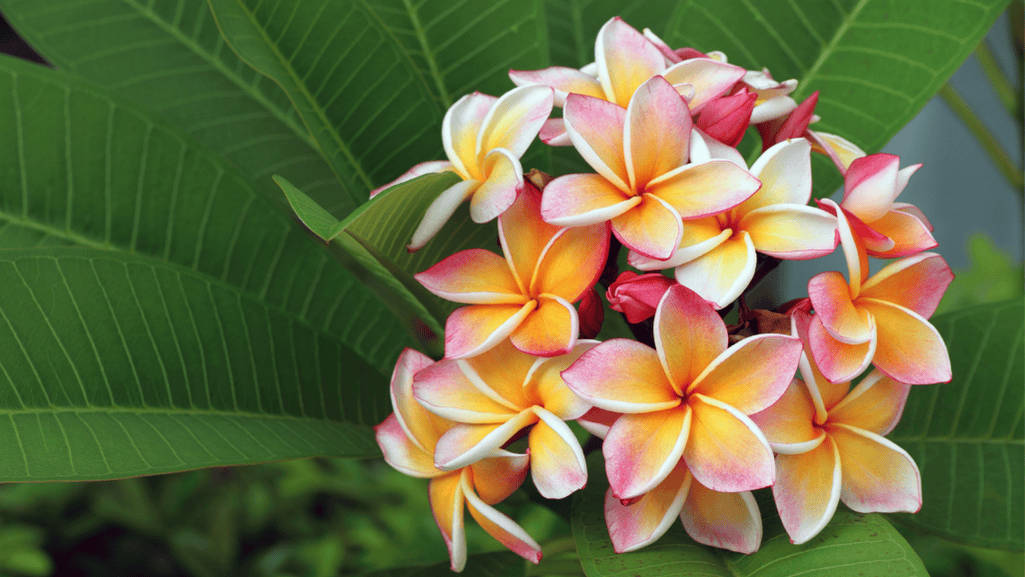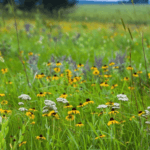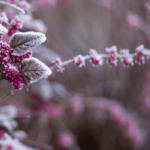
Beautiful flowers gardenia Plants For Your homes

Plumeria flowers, also known as frangipani or Hawaiian lei flowers, are tropical plants that belong to the Apocynaceae family. They are loved worldwide for their beauty and sweet smell. These flowers are a symbol of the tropics, used in leis, luau decorations, and gardens around the world.
Plumerias come from Central America, South America, and the Caribbean. They thrive in tropical and subtropical climates. The name “frangipani” honors a 16th-century Italian nobleman, Marquis Frangipani, who made a perfume like the flower’s scent. Today, plumerias are valued for their beauty, cultural importance, and the happiness they bring to those who grow and enjoy them.
There are over 300 types of plumerias, offering many colors, shapes, and sizes. From classic white and yellow to bright pink and red, they add beauty to any garden. Their delicate petals and sweet smell make them perfect for lei making and decorating with flowers.
Plumerias mean a lot in culture and spirit. In Hawaiian culture, they’re key to celebrations and ceremonies, standing for love, respect, and admiration. They also have a special meaning in Hindu and Balinese traditions, symbolizing beauty, charm, and life’s fleeting nature.
Plumerias, also known as Frangipanis, have a rich history and cultural significance across many regions and traditions. These flowers, native to Mexico, Central America, Southern India, and Venezuela, have captured hearts for centuries with their beauty and fragrance.
The story of Plumerias began in the mid-19th century in Mexico’s southern forests. In 1860, German botanist Wilhelm Hillebrand brought the first Plumeria to Hawaii. This marked the start of a beautiful relationship between the flower and Hawaiian culture.
In Hindu traditions, Plumerias are sacred and called temple trees. They are offered to deities as a symbol of devotion and spiritual connection. In Bali, Plumerias are key in religious ceremonies and decorate temples and shrines.
Plumerias mean more than just religious symbols. In Hawaiian culture, they’re used in lei making, a tradition of stringing together fragrant flowers. Leis symbolize love, friendship, and celebration. Plumerias add elegance and grace to these floral garlands. For tips on caring for Plumerias, check out https://flowersgardenia.com/cape-plumeria-care/.
Plumerias inspire art, from paintings to jewelry, and fabric prints. Their iconic shape and colors represent tropical beauty and island life.
The name “Plumeria” comes from French monk Charles Plumier, a 17th-century botanist. He wasn’t the first to discover the plant, but his work earned him the genus name.
From Aztec medicine to Polynesian hairstyles, Plumerias have a wide cultural impact. They adorn temples, cemeteries, and symbolize eternal life. Plumerias have left a lasting mark on human culture.
Plumerias, also known as Frangipani, are captivating flowering plants loved by gardeners and nature lovers worldwide. Their beautiful blooms and sweet scent make them a symbol of tropical beauty. Let’s explore the anatomy of these flowers and the many varieties found in our gardens.
Plumeria flowers are famous for their bright colors and unique petal shapes. You’ll often see them in pure white, soft pink, sunny yellow, and bold red. Some have stunning bicolored or multicolored petals, adding to their beauty. The petals can be round, long, or even pointed, making each one special.
| Petal Shape | Description | Example Cultivar |
|---|---|---|
| Rounded | Classic, symmetrical shape with smooth edges | Singapore Pink |
| Elongated | Slender, pointed petals that create a more dramatic look | Celadine |
| Overlapping | Petals that slightly overlap, creating a fuller appearance | Aztec Gold |
| Ruffled | Petals with wavy or ruffled edges, adding a touch of elegance | Candy Stripe |
The plumeria genus includes many species and hybrids, each unique. Some stand out:
Plumeria fans have also created many hybrids, each with unique colors, shapes, and scents. Some popular ones are:
With over 300 recognized plumeria varieties and countless hybrids, gardeners have a wide range to choose from. Whether you like the classic Singapore Pink or the exotic Celadine, there’s a plumeria for everyone. Each variety can make your garden more beautiful and unique.
Plumerias are known for their sweet smell and bright colors. They are a true sign of tropical beauty. Growing these flowers is rewarding, and with the right care, you can enjoy their beauty every year. They do best in USDA hardiness zones 10-12, perfect for gardeners in warm areas. To help your plumerias grow well, it’s important to know what they need and provide the best conditions.
Choose a spot for your plumeria that gets at least six hours of sun a day. These plants love the sun and need it to grow and bloom well. They can handle some shade but too much can make them grow tall and not bloom much. They prefer soil that drains well and is a bit acidic. A loamy soil is best for them.
Plumerias can grow quite tall, up to 30 feet, and wide, up to 25 feet. So, make sure you have enough space for them to grow. Summer Winds Nursery suggests they can get quite big, so plan your garden space well.
Watering your plumeria right is key to keeping it healthy. Water it deeply, letting the soil dry out a bit between waters. Too much water can cause root problems and slow growth. During spring and fall, when they’re growing, they need more water. But, in winter, when they sleep, cut back on watering to prevent root rot.
Feeding your plumeria with the right fertilizer is also important. Use a balanced fertilizer during the growing season. Look for one with more phosphorous, like a 10-30-10 ratio, to help flowers grow. Feed them every two to four weeks, as the package says. Stop fertilizing in winter when they’re dormant.
Pruning your plumeria regularly is a must. It keeps the tree healthy and bushy, and helps it bloom more. Prune in late winter or early spring, before they start growing again. Cut off dead, damaged, or crossing branches to keep air moving and prevent diseases. This also makes the plant fuller and more compact.
When pruning, cut branches up to 12 inches from the ground, depending on what you want your plumeria to look like. After pruning, your plumeria might look a bit bare at first. But don’t worry, it will grow back strong and beautiful.
| Plumeria Care Aspect | Recommendation |
|---|---|
| USDA Hardiness Zones | 10-12 |
| Sunlight Requirements | 6 hours of full sun per day |
| Soil Type | Loamy, well-drained, slightly acidic |
| Fertilizer | Balanced, water-soluble, higher phosphorous content (e.g., 10-30-10) |
| Pruning Time | Late winter or early spring |
| Pruning Height | Up to 12 inches (31 cm) from the ground |
Follow these tips for plumeria care, and you’ll have a beautiful garden. Remember, patience is key. Flowers Gardenia says it can take one to three years for plumerias from cuttings to bloom. But the wait is worth it for the stunning colors and scents they bring.
Plumerias are a favorite in tropical gardens for their beautiful blooms and sweet scents. To keep them thriving, learning how to propagate and repot them is key. You can grow new plants from stem cuttings or seeds, both methods bring great rewards.
Stem cuttings are a popular way to grow new plumerias. Start with a healthy stem, 12 to 18 inches long, without any damage. Remove any flower stalks to help the cutting focus on growing roots.
Wrap the cutting in plastic or damp coconut coir for two weeks. This helps the cut end heal and prepare for roots. Once ready, plant it in a pot filled with a mix of cactus soil and perlite or pumice. This mix prevents rot and ensures good drainage. Water the cutting well to settle the soil. Soon, you’ll see new leaves growing, showing the roots are doing well.
Seed propagation takes longer than cuttings but is rewarding. Plant the seeds in a mix that drains well and keep it moist until they sprout. This can take weeks. Remember, the new plants might look different from the parent plant.
Plumerias do well when slightly root-bound, so repot them only when needed. This is usually when they’ve outgrown their pot or when you’re moving a cutting. Repotting is best done in the dormant season, in fall or winter.
| Repotting Plumerias | Key Considerations |
|---|---|
| Frequency | Annually, during dormant period (fall or winter) |
| Container Size | One size larger than current container |
| Soil Mix | Well-draining; 2 parts peat, 2 parts potting soil, 1 part compost, 1 part coarse sand |
| Root Health | Check for rootbound conditions; gently loosen roots before repotting |
When you repot, pick a container one size bigger than the old one. This stops the soil from staying too wet, which can harm the roots. Use a mix of peat, potting soil, compost, and coarse sand for the best drainage and moisture.
Learning how to propagate and repot plumerias will help you grow a beautiful garden. Enjoy the process of caring for your plumerias and watch them become a stunning part of your garden.
Hawaiian plumerias have won the hearts of people worldwide with their bright colors and sweet scent. They were introduced by Dr. William Hillebrand in 1860. Now, they’re a big part of the Aloha spirit, standing for love, beauty, and romance.
The islands are home to many plumeria types, each with its own charm. The ‘Kauai Beauty’ has pink and yellow colors like a stunning Hawaiian sunset. The ‘Maui Sunset’ has peach and pink hues, reminding us of a peaceful tropical place. The ‘Lei Rainbow’ is known for its colorful flowers, great for making traditional Hawaiian leis.
Plumerias come in many colors, from white to red. Yellow ones symbolize happiness and friendship. Red ones stand for love and passion. The five petals of the plumeria flower represent love, faith, charity, hope, and devotion, showing the heart of Hawaiian culture.
| Plumeria Variety | Colors | Significance |
|---|---|---|
| Kauai Beauty | Pink and Yellow | Reminiscent of a Hawaiian sunset |
| Maui Sunset | Peach and Pink | Evokes warmth and tranquility |
| Lei Rainbow | Multi-colored | Perfect for traditional Hawaiian leis |
In Hawaii, plumerias are a big part of the culture. Many people grow them in their gardens, making their homes smell sweet. The plumeria’s scent is linked to the islands’ warm welcome and hospitality.
Creating leis with plumerias is a special tradition. These flower garlands are given as symbols of love and respect. A plumeria behind the left ear means you’re in a relationship. Behind the right ear means you’re looking for love.
With over 300 species, plumerias are a favorite among gardeners and flower lovers. If not pruned, these trees can grow up to 12 feet tall. Hawaiian plumerias are more than just beautiful flowers; they capture the Aloha spirit, teaching us about love and joy in Hawaii.
The plumeria flower is a symbol of tropical beauty, loved worldwide for its sweet smell and bright colors. It’s found in Hawaii’s lush landscapes and Southeast Asia’s peaceful gardens. Plumerias stand for love, devotion, and the Aloha spirit in many cultures.
Plumeria flowers are known for their strong, sweet smell that gets even stronger at night. This scent makes them a top pick for scented gardens and outdoor spaces. Their fragrance is so strong, it’s used in perfumes and essential oils, bringing tropical scents to anyone, anywhere.
Plumerias come in many colors, like white, pink, yellow, and red. Each color means something special, like yellow for positivity and red for love. The Plumeria alba is the most common, found in white, cream, yellow, pink, and red.
Plumerias are more than just pretty flowers; they’re important in Hawaiian culture. They’re used to make beautiful floral arrangements and leis. In Hawaii, making leis with plumerias is a tradition. These garlands show love and welcome.
| Cultural Significance | Meaning |
|---|---|
| Hawaiian | Represents the spirit of Aloha (love, kindness, respect) |
| South Indian | Used in weddings for garlands and hair adornments |
| Hindu | Used for deity worship |
| Buddhist | Symbolizes immortality |
| Chinese | Considered more special than orchids, associated with love |
| Mayan | Featured in art, symbolizing life and birth |
| Vietnamese | Believed to possess healing properties for skin inflammation |
The five petals of the plumeria stand for love, faith, charity, hope, and devotion. They add meaning to celebrations and personal moments. Let the beauty, scent, and cultural importance of plumerias enchant you.
Florida’s warm, tropical climate and plenty of sunshine make it perfect for plumerias. These plants are known for their bright colors and sweet smell. With the right care, they can do well in Florida.
For plumerias to grow well in Florida, they need well-draining soil. A mix of sand, perlite, and organic matter works great. This mix lets water drain well and prevents roots from getting too wet.
Plumerias can handle some drought but need regular water, especially in summer. Water them deeply, but let the soil dry out a bit before watering again. This prevents root rot.
Plumerias love 6-8 hours of strong sun each day. Pick a spot in your garden that gets lots of sunlight. They’re perfect for tropical climates, fitting in USDA Hardiness Zones 10B-11. In Central Florida, they might face frost risks in USDA Hardiness Zone 9B.
| Watering Frequency | Soil Type | Sunlight Requirements |
|---|---|---|
| Water deeply, allowing soil to dry between watering | Well-draining mix of sand, perlite, and organic matter | 6-8 hours of intense sun daily |
Florida’s climate is usually warm, but it can get cold in winter. To keep plumerias safe, cover them with frost cloth or bring potted plants inside if it gets below 40°F (4°C). For plants in the ground, mulching around the base can help keep roots warm.
Plumerias might get a yellow “rust” fungus if their leaves stay wet. To avoid this, don’t soak the leaves when you water and make sure air can move around the plants. Watch out for pests like spider mites, whiteflies, scale, and mealybugs, as they can harm your plumerias.
With the right conditions, including good soil, regular water, plenty of sun, and cold protection, you can enjoy plumerias in your Florida garden for many years.
Growing plumerias in California is rewarding, thanks to the state’s diverse climate. Coastal plumerias love the mild temperatures and ocean influence. They’re perfect for seaside gardens. Make sure to plant them in a sunny spot with good drainage. You’ll also need to add nutrients often because of the marine-layer fog.
Inland plumerias need extra care in the heat. They love the sun but can get stressed in extreme heat. So, give them some shade during the hottest part of the day. Make sure they get enough water, especially when it’s hot. You might need to add soil amendments depending on where you live in California.
To help your plumerias grow, add organic matter to the soil. Mulching around the plant keeps the soil cool and moist. If you live in a frosty area, consider growing them in pots. This way, you can move them inside when it gets cold.
Here are some tips to keep your California plumerias happy:
Want to grow your own plumerias? Here’s how:
With the right care, your California plumerias will give you beautiful flowers and a tropical feel for years.
Growing plumerias in Texas is rewarding because they love the warm weather. These tropical plants bloom in early spring and summer. They bring bright colors and a sweet scent to gardens. To make sure they grow well, focus on soil drainage and providing shade from the Texas heat.
Good drainage is key for plumerias, as they can handle poor soil. Texas gardeners should use well-draining soil to avoid waterlogging. Adding sand or perlite to the soil mix helps with drainage and prevents root rot.
For plumerias in pots, make sure the pot has good drainage holes. A good mix for Texas plumerias includes:
This mix keeps the soil moist but prevents water from gathering around the roots. Good drainage and soil are key for plumerias to do well in Texas.
Plumerias love sunlight but can’t handle too much Texas heat. In very hot areas, giving them some shade in the afternoon helps. This keeps them healthy and happy.
| Shade Options | Benefits |
|---|---|
| Shade cloth (30-50% shade) | Reduces sunlight intensity while allowing adequate light for growth |
| Nearby deciduous trees | Provide dappled shade during summer and allow more sunlight in winter |
| Lattice or pergola structures | Create a partially shaded environment for plumerias |
When it gets colder than 60°F, plumerias grow and bloom less. In these cases, bring them inside or to a sheltered spot. The right amount of sunlight and shade helps your plumerias do well in Texas.
With proper soil drainage and strategic shade placement, growing plumerias in Texas can be a delightful and rewarding experience. Follow these tips to create a beautiful tropical garden in Texas.
Plumeria plants are a symbol of tropical beauty loved by gardeners worldwide. They have vibrant colors, a sweet scent, and lush leaves. These plants add a touch of paradise to any garden or outdoor area.
To grow Plumerias well, you need to know their ideal conditions. They prefer soil that drains well and has a pH between 6.0 and 6.5. They also like temperatures between 65°F and 80°F.
It’s important to water, fertilize, and prune them properly. This keeps them healthy and encourages lots of flowers. Plumerias can grow well in places like Hawaii, Florida, California, and Texas with the right care.
The Rio Plumeria is a popular variety known for its compact size, lots of blooms, and beautiful orange and pink flowers with red stripes. It costs between $24.50 and $35.00. This variety is a favorite for its reliability and lovely scent.
Starting to grow Plumerias can make your surroundings more beautiful. It can also make you feel calm and happy, like you’re in a tropical paradise right at home.




